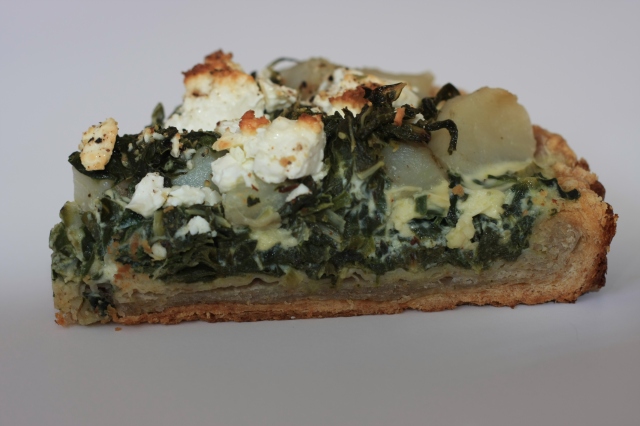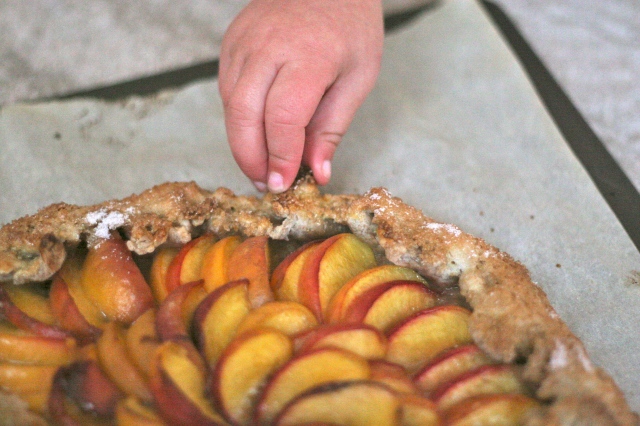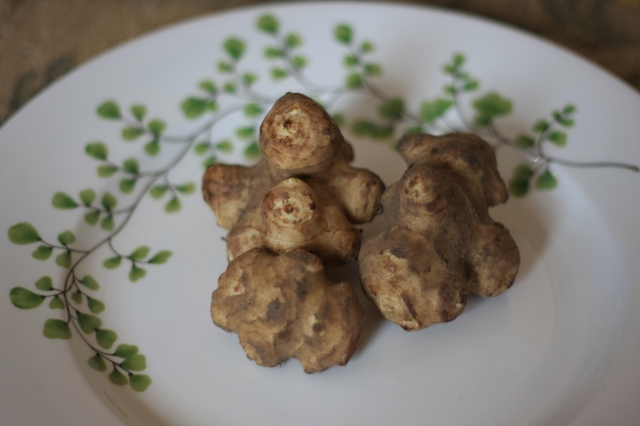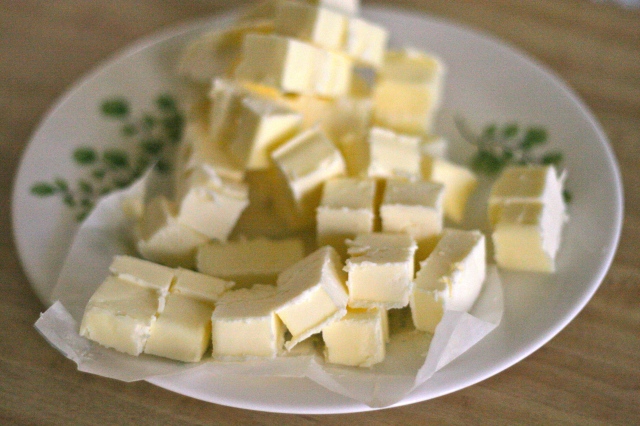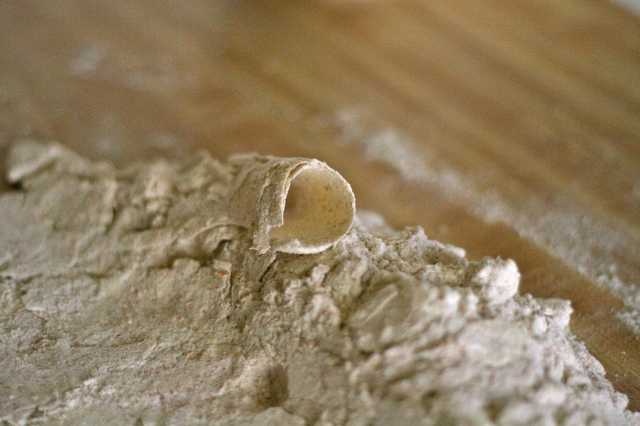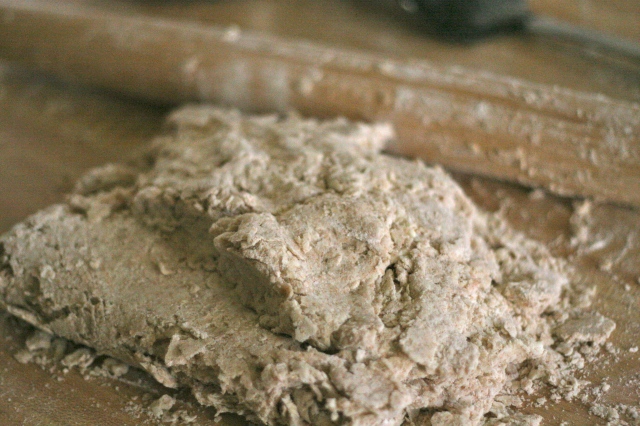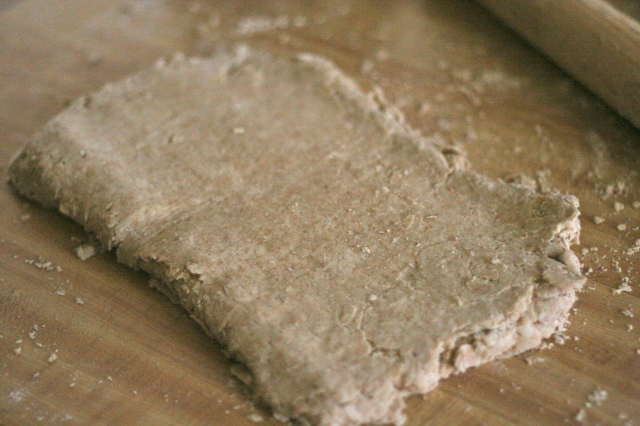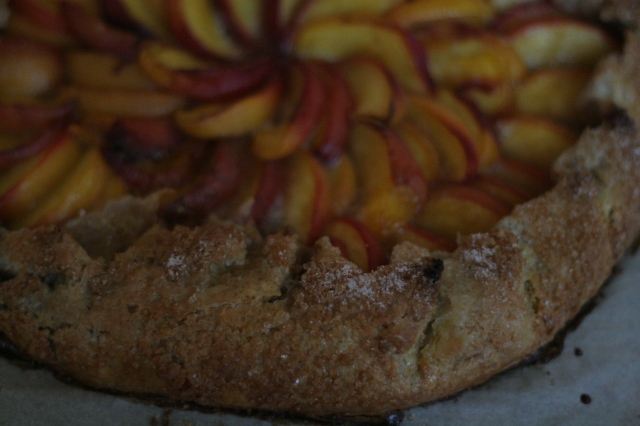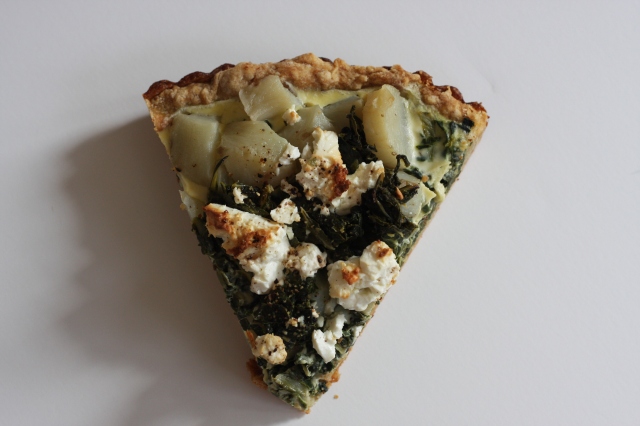I have been meaning to share a fantastic tart/crust/pastry technique with you for a long while, but due to problems with the new camera that we inherited, have not gotten around to actually photographing it. This would make a great base for a Valentine’s Day treat. The most important part of the dough is its very simple, but magical technique.
With this trick, fine whole wheat pastry flour creates a base for a juicy jammy blackberry tart that shatters into a buttery crunch of shards you can sweep into a pile of crumbs on your plate and subsequently tip into your mouth.
Spelt and rye flours make their way into various sweet stone fruit galettes in July and August.
And though a free formed fruit tart sounds heavenly just about anytime (like a pistachio frangipane galette with pears, hmmmm), my favorite use for this pastry dough of late is in a savory tart.
A couple of weeks ago we picked up a Mystery Box from Mariquita Farm and as much as I adore sweet, fragrant, and abundant summer produce, I have a soft spot for the vegetables that they grow this time of year. Spigariello, octopus-tentacled Italian dandelions, Portuguese cabbage Couve Tronchuda, Swiss chard, baby turnips, sweet and gnarled winter carrots, and knobby sunchokes.
What do you do with sunchokes? I have only used them raw in salads, and they are crunchy and delicious, much like a barely sweet jicama. I have also had them thinly sliced and fried like potato chips and added to all kinds of dishes. For a couple of years I had been eying a quiche-like tart with sunchokes in the Ottolenghi cookbook, but never simultaneously had sunchokes in the fridge, until last week.
Cooked sunchokes loose their grainy (but pleasing) jicama type texture and convert into a silky, firm root vegetable. It is as though it were an entirely different ingredient. I also had Swiss chard in our garden and the Portuguese couve tronchuda, many Meyer lemons, and a lot of homemade creme fraiche that I had not assigned to anything yet. And so my favorite savory tart was born.
But first you need that pastry base.
This technique is basically like making a really rough puff pastry dough, but with some ice water. Chilled butter layers create pockets that melt and then steam while cooking so that you end up with an incredibly tender and flaky crust. First cut your butter into roughly 1/2 inch to 1 inch cubes and set in the freezer for at least 15 minutes. While the butter is chilling, measure out your flour, salted ice water, and a little bit of a sea salt that has some panache (Maldon, grey, fleur de sel, or even a cheap coarse sea salt all do great).
Sprinkle most of the flour and salt out on your work surface and spread the near-frozen butter cubes on top with just a dusting of the rest of the flour to prevent the butter from sticking to your rolling-pin too much.
 Start rolling. You want the butter to flatten out like little cat tongues.
Start rolling. You want the butter to flatten out like little cat tongues.
Take a spatula or bench scraper (if you have one), and scrape it all back into a pile and repeat the rolling. Scrape and roll once or twice more.
Now form a little depression in the middle of the butter flour mixture and pour in your salted ice water. With your bench scraper/spatula, scrape the outsides into the liquid in the middle and keep cutting in until the whole mass becomes roughly stuck together.
Finally, sprinkle a bit of flour and roll out the dough once more into a rectangular shape. Fold in the edges, flip the dough so the smooth side is up and roll out again once, repeating once or twice. End with a nice neat folded package and plastic wrap in the freezer for months or in the fridge for 2 hours to a week before using.
If you are making a free form tart, like a galette, roll it out, fill it, and let it sit in the freezer or fridge for at least 20 minutes before cooking it. If you plan on making a formed tart in a pie or fluted free bottom tin, roll out the dough and press it into the form and likewise refrigerate at least 20 minutes before cooking it.
As for the savory tart, this is one instance where I advocate blind baking it ahead of time. If you read this blog, you probably already know what that is, but just in case you do not, it means you have to partially pre-bake the tart shell before filling it and cooking it the rest of the way. The other thing I suggest is to cook it a bit lower than your usual U.S. of A. standard 350F degrees. With a long cook time I always feel that pie crusts and tart crusts cook beyond flaky and delicious and end up tasting dry, chalky, and burnt. Arbitrary as it may sound, go for 330 or 340F. (See the top photo again and notice the flaky layers even on the bottom of the tart.)
Finally, choose your cheese wisely. A really good feta cheese makes all the difference here. I am very fond of Bulgarian and Israeli fetas in this tart tucked in big chunks all around the top. Enjoy the best crust you will ever have and Happy Valentine’s Day!
Galette or Tart Crust
(makes 2)
600 g total flour (my favorite versions include 50/50 whole wheat pastry flour and all-purpose unbleached flour, 25% spelt with %75 all-purpose, and 50/50 rye and white pastry flour, but you could also do 100% all-purpose flour if you don’t mind hearing me grumble about how boring you are)
1/2-3/4 teaspoon of your larger grained sea salt (coarse, Maldon, fleur de sel, etc.)
1/2 teaspoon kosher salt
320g almost frozen butter, cut into 1/2-1 inch cubes
140ml ice water
Mix the kosher salt with the ice water and keep ready in the freezer or with a couple of ice cubes in it.
Mix together your flours and your sea salt and dump out most of it into a rectangle on your work surface. Lay the butter cubes on top and dust with the remaining flour so that your rolling-pin does not stick. Roll out so that the butter cubes begin to flatten and elongate like cat tongues. Scrape the mixture back to the center and repeat two more times.
Make a depression in the middle of the flour-butter mixture and pour in the ice water. Slowly scrape the flour mixture from the outside and cut into the water in the middle and repeat until you have a nice shaggy mess of mostly uniform dough.
Dust lightly with flour and roll out to a rectangle and then scrape the edges back in, flip over so the folded parts are underneath and repeat (roll, fold, flip) once or twice more. Cut into two doughs. You should end up with nice cohesive pastry dough packages that you can plastic wrap and refrigerate for 2 hours to a week or freeze for a couple of months. See directions above about how to proceed if you are making a sweet (or savory) galette.
Chard, Feta, and Sunchoke Savory Tart
(adapted from Ottolenghi)
1 tart crust
500-600g of sunchokes/ Jerusalem artichokes, scrubbed, peeled and cut into 1 inch cubes
3-4 tablespoons olive oil
1 massive or 2 small bunches of chard (or Couve Tronchuda if you can get your hands on it)
1-2 Tablespoons Meyer lemon (or lime, etc.)
1 garlic clove, crushed
235ml creme fraiche
2 eggs
150g Israeli or Bulgarian feta cheese
salt and pepper
Preheat the oven to 330-340F. Roll out the tart crust and fit it into a free bottom tart pan, if you have one. Press it into the sides so that there is a bit of overhang. Refrigerate for 20 minutes and then prick the bottom all over with a fork. Lay a circle of parchment paper on top of the base and cover with either pie weights or old beans, split peas, etc. that you don’t mind keeping just for this use. Cook for 35 minutes and then remove the parchment paper and beans and cook for another 5 or so minutes. Allow to cool, but leave the oven on. (Can be done well in advance, even the night before.)
While your crust is cooking, cook the cubes of sunchokes in salted water until fork tender. Drain and let cool. Prepare your chard or Portuguese couve tronchuda. Head 3-4 tablespoons olive oil in a large frying pan on medium high heat. Lay your cleaned leaves in a bed and then roll them up into a cigar shape and slice very thinly into ribbons. Chop once or twice more so the ribbons are not too long and then saute in the pan until they are wilted and have released a good deal of liquid. Turn off of the heat and quickly add 1-2 crushed garlic cloves and squeeze in your Meyer lemon juice. Let cool a bit.
Whisk together the creme fraiche and eggs with a little salt and pepper. Carefully layer the sautéed chard and the sunchokes in the tart shell so that both vegetables show in different places. Sprinkle the large chunks of feta cheese on the top and finally slowly pour the creme-egg mixture in the shell so that it does not spill over the top. Sprinkle a tiny bit more salt and freshly cracked pepper on the top and put in the oven to cook for 15 minutes uncovered. Remove the tart and tent it in aluminum foil and return to the oven to cook for another 30-40 minutes, until the center is no longer jiggly and the custard has fully formed between the vegetables. If need be, you can take the aluminum foil off for the final five minutes of cooking.
Let stand to cool for 5 minutes before eating, if you like it hot, or let cool for a full hour if you prefer it at room temperature.

